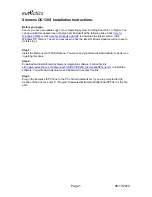
Custom Device Monitoring Programming
39
RMS NetLinx Programmer’s Guide
You may notice that for power state, you can PULSE channel 27 or 28 to set the
state. Since most IR files store the power functions on these channels, no
additional programming is needed to send power state to the module when using
these channels to control power. Also, power status is monitored on channel 255
which is often linked to a power sensing device connected to an IO device. If you
are using an IO device to monitor power, the IO status should be set to report on
channel 255 of the real device. In some cases, this requires a 'SET IO LINK'
command to be sent to the real device. In these cases, simply pass the real device
Notify Modules
Turn Power On:
RMSSetDevicePower(dvProj,TRUE)
SEND_STRING vdvVPROJ,'POWER=1'
PULSE[vdvVPROJ,27]
ON[vdvVPROJ,255]
Turn Power Off:
RMSSetDevicePower(dvProj,FALSE)
SEND_STRING vdvVPROJ,'POWER=0'
PULSE[vdvVPROJ,28]
OFF[vdvVPROJ,255]
Set Lamp Hours
RMSSetLampHours(dvProj,Value)
SEND_STRING
vdvVProj,'LAMPTIME=Value'
Set Transport State (1=Play,
2=Stop, etc…):
RMSSetTransportState(dvVCR,State)
SEND_STRING vdvVCR,
'TRANSPORT=State'
PULSE[vdvVCR,State+240]
Where State is:
1
Play
2
Stop
3
Pause
4
Fast Forward
5
Rewind
6
Search forward
7
Search Reverse
8
Record
Содержание RMS 3.0
Страница 1: ...Software NetLinx Programmer s Guide RMS Resource Management Suite 3 0 ...
Страница 4: ......
Страница 10: ...Overview 2 RMS NetLinx Programmer s Guide ...
Страница 12: ...System Requirements 4 RMS NetLinx Programmer s Guide ...
Страница 22: ...Concepts 14 RMS NetLinx Programmer s Guide ...
Страница 62: ...Custom Device Monitoring Programming 54 RMS NetLinx Programmer s Guide ...
















































